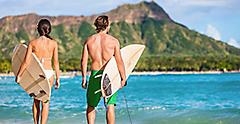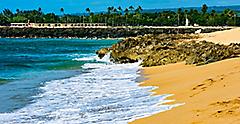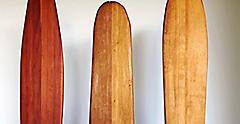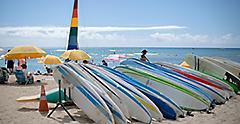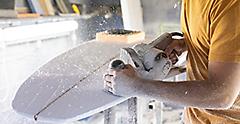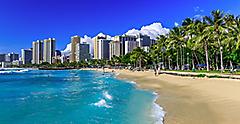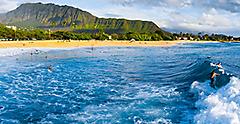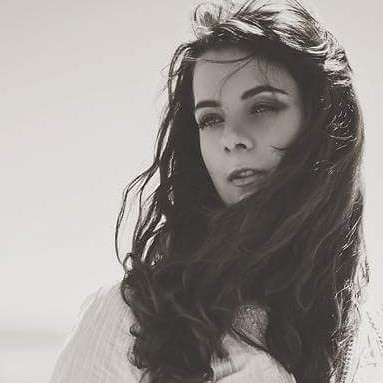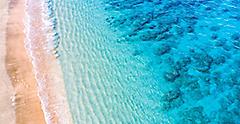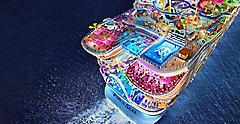Dive Into The Epic History Of Hawaiian Surfing
The Birthplace of Modern Surfing
By Claire Heginbotham | Published on September 29, 2023
Hawaii is a dreamy vision of laid-back white sand beaches, bright blue waters, tropical flowers and surfing. How did this quiet island paradise become the mecca of such an extreme sport such as surfing? The history of Hawaiian surfing goes all the way back to when the Polynesians arrived on the Hawaiian islands as early as 400 C.E. after an epic journey. They had rowed their canoes for days from Polynesian Islands like Tahiti to touch down on new tropical shores. Drawn to the excitement of waves, a culture of surfing slowly emerged and soon exploded.
Hundreds of years later, in 1779, Captain James Cook's successor Lieutenant James King, took the first written records of surfing.
On seeing the local surfers, King wrote, "They lay themselves at length upon their boards … their first object is to place themselves on the summit of the largest surge, by which they are driven along with amazing rapidity toward the shore. The boldness and address with which we saw them perform these difficult and dangerous maneuvers was altogether astonishing."
As a surfer myself, I'm happy to say that not much has changed with this spiritual practice of surfing. Unsurprisingly, Hawaii is at the center of why this cool sport remains so popular today.
The History Of Royal Surf Culture In Hawaii
Have you ever heard someone be called "King of the Waves" after a particularly good surf session? That's because Hawaiian surfing was originally a royal sport. Kings claimed prime surf spots throughout the islands, reserved for royalty alone. Peasants were never allowed to surf these spots and were deterred by the punishment of death. That's not all; if a royal was surfing, you'd have to be extra careful when wave riding — if you dropped in on a king, the punishment was just as severe!
Fun fact: Traditional Hawaiian surfboards were made of solid wood and weighed over 175 lb. That's heavy enough to do some serious damage to an unsuspecting king or queen.
I wouldn't feel too bad for the non-royal residents of Hawaii, though. Thanks to Hawaii's fertile land, they lived a better lifestyle than their European counterparts. They had ample time for rest and relaxation, and their surf culture thrived. On days when the surf was good, Hawaiians would take to the waves on their longboards.
While royal dibs on surf breaks are long gone, you can still experience epic waves at these stunning Hawaiian surf spots and beaches.
- Pua'ena Point, Oahu. The place to surf in Oahu. It has great waves for all levels of surfers, from beginner to pro.
- Cove Beach Park, Maui. Usually, when you think of Maui surf culture, you think of adrenaline-addicted extreme surfers rushing down gnarly waves the height of skyscrapers. Cove Beach isn't like that; it's a great destination for longboarders looking for a mellow, long ride to shore. It's a fantastic place to learn how to surf. If you're looking for those big waves, head to the Peahi or "Jaws" break.
- Haleiwa Beach Park, Oahu. An excellent spot for beginner surfers and casual swimmers.
- Diamond Head, Honolulu. Impressive views and beginner-friendly surf — what's not to love?
- Waimea Bay, Oahu. This is where the famous band The Beach Boys used to surf. The waves here get pretty big, so even just spectating is a thrill.
If you're cruising to Hawaii but aren't sure you're ready to brave the ocean waves and try surfing for yourself, don't worry! You can practice your technique on the way there on the FlowRider* Surf Simulator. This onboard activity is just one of the reasons why Royal Caribbean is the best Hawaiian cruise line around.
The Evolution Of The Surfboard Design
Sculpting a surfboard was sacred to the first surfers of Hawaii. The process of making a board began with offering a ritualistic fish called a kumu to the roots of a tree. The tree was then cut and roughly shaped using a bone adze — a tool similar to an axe — and refined with coral and stone. The board was blackened using natural materials like burned kukui nuts, ti plant roots, or banana buds. A craftsman's final step was to coat the board with kukui nut oil to seal the wood and provide a shiny finish.
Much like today, a good surfboard was a treasured possession that required time and effort to maintain. Like we apply wax to boards, ancient Hawaiians would rub the board with coconut oil and wrap it in a tapa cloth to preserve the wood.
Native Hawaiians made three types of surfboards. First, Alaia boards were 7 to 12 feet long and were made from heavy Koa wood. Alaias were considered commoner boards. This was the very same board Captain Cook first witnessed in 1778. Olo boards were exclusively used by longboard-loving Ali'i (royalty), who were expert surfers. Measuring 10-20 feet, they were giant compared to Alaia boards. They were made with lower-density wood from the Wiliwili trees to compensate for their length. These boards still weighed in at almost 200 lb (90kgs). And Paipo boards were only about 3 to 6 feet long and were round-nosed boards ridden mainly by children and commoners.
During the 19th century, missionaries arrived in Hawaii, and the development of wooden boards slowly declined and nearly stopped altogether. But a core faction of secret surfers kept the tradition and culture of sport alive. In 1905, a young Hawaiian surfer named Duke Kahanamoku and his friends began to attract fame.
So where can you go to see these old boards? In my experience, the best place to experience surf history is in every single surf shop you walk past. Forget pricey museum admissions because these shops have dozens of old boards from locals lining their walls. For example, the North Shore Surf Shop in Haleiwa Town has impressive historic boards stored in the rafters along with signed displays.
Hotels also pay tribute to the history of surfing in Hawaii with boards, photos, and memorabilia installations. Check out Moana Surfrider Hotel in Honolulu and Outrigger Waikiki Beach Resort in Waikiki to wander through some impressive collections.
How Surf Culture In Hawaii Came To Be And Is Still Alive Today
Duke Kahanamoku is the original "surfer dude" and the father of modern surfing culture. He was revered by Hawaiian society as a "waterman" and was swimming before he could walk. He won his first Olympic gold medal in 1912 for the 100-meter freestyle at the Stockholm Olympic Games and was automatically catapulted into the spotlight.
Kahanamoku's fame grew as he went on to win five Olympic medals for swimming! He was later named the official Ambassador of Aloha, appeared in Hollywood movies, and saved eight men from drowning, inventing the idea of a lifeguard.
Kahanamoku traveled the world with his friend George Freeth, spreading the popularity of surfing and showing off their surfing skills. They toured the east and west coasts of the U.S., made waves in the cold water of Southern California, starred in Australia's first-ever surfing exhibition, and even traveled to New Zealand. His efforts in Australia were particularly effective. Kahanamoku later said, "Before I left that fabulous land, the Australians had already turned to making their own boards and practicing what I had shown them in the surf."
By the 1930s, the surfing craze firmly gripped the world's imagination. Any Hawaii vacation was not complete without trying your hand at surfing. Even navy officers during WWII traveled with surfboards bought from a Hawaii port of call. These officers spread surfing even further, taking them to far-flung destinations. As a child, my grandfather remembers seeing the first surfboards arrive with navy officers at Muizenberg Beach in South Africa during the early 40s!
Get Royal Deals, Sign Up Today
Related Articles

Family Cruise Activities on Ovation of the Seas
READ MORE
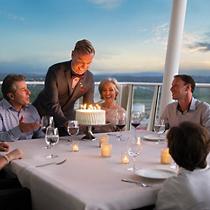
Cruises are the Best Birthday Weekend Getaways | Royal Caribbean Cruises
READ MORE

10 Galveston Camping Tips | Royal Caribbean Cruises
READ MORE

The World’s Largest Swim-up Bar: Top Things to Do at Party Cove
READ MORE

